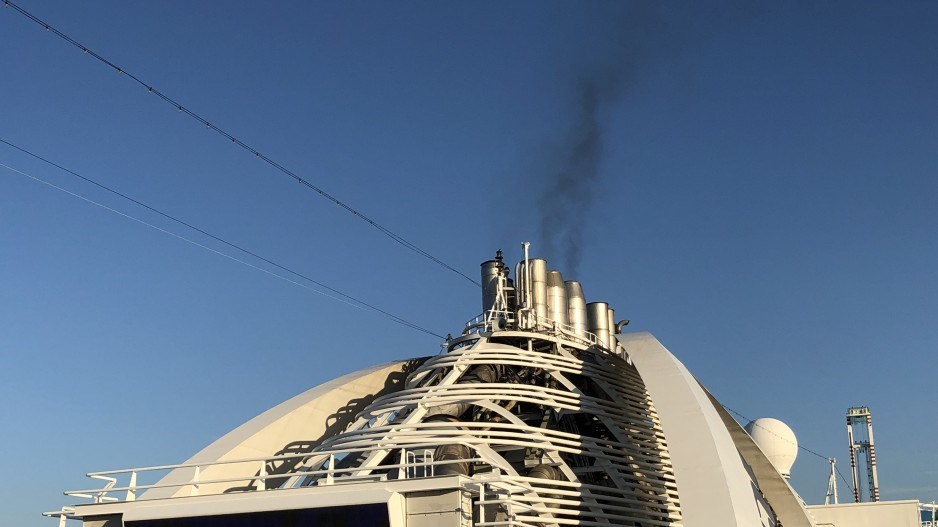Roughly 26 million people who go on cruises every year may be breathing in unhealthy amounts of pollution, according to an undercover study done for Stand.earth by a Johns Hopkins University professor.
Stand.earth is using the study to try to pressure Carnival Corp. (NYSE:CCL) – the world’s largest cruise ship company – to switch to cleaner burning fuels.
But one of the cleanest burning fuels for shipping is liquefied natural gas (LNG). Yet when asked if Stand.earth supports the idea of a liquefied natural gas bunkering facility in Vancouver for cruise ships and other vessels, Stand responded: “We do not support LNG.”
Instead, Stand.earth wants to see Carnival switch from bunkering fuel to diesel. Stand.earth is focusing its campaign on Carnival because it is the world’s largest cruise ship operator.
As part of the study, Ryan Kennedy, an assistant professor at the Johns Hopkins University Bloomberg School of Public Health, went on four cruises and took readings of the air while on board with a hand-held device. One of the cruises was from Vancouver to San Francisco and Los Angeles.
The conclusions of his study were published by Stand.earth, but had not been published in any science or medical journals, and therefore has not been subject to peer review.
Kennedy took regular readings of ultra-fine particulate matter at the front and back of the ships. Ultra-fine particulate matter can cause a range of health problems.
Not surprisingly, he found much higher concentrations of ultra-fine particulate matter at the stern of the ship. The stern, after all, is behind the ship’s exhaust stack, so concentrations of exhaust will be higher behind the smokestack when the ship is moving.
It’s the concentrations that were “shocking,” according to Kendra Ulrich, Stand.earth’s senior shipping campaigner.
“Some of the particulate counts were comparable to, or worse than, a bad day in some of the world’s most polluted cities, like Beijing and Santiago,” she said.
She added that the highest counts were frequently on the running track and exercise areas of the ships.
It’s not just those aboard the cruise ships that may be subjected to high levels of ultra-fine particulate matter, Ulrich said. So are port cities like Vancouver, as well as coastal communities in general.
“Studies have shown that nearly 70% of global ship emissions happen 250 miles of shore,” she said. “This pollution can travel far inland and expose millions of unsuspecting people to ship emissions.”
In response to the study, Carnival questioned both the study’s methodology, as well as Stand.earth’s motivations.
“We have installed Advanced Air Quality Systems on nearly 80% of our global fleet in close coordination with the EPA, so these systems are environmentally friendly, in addition to rolling out new ships powered by LNG, the cleanest burning fuel available, so their study is misleading and inaccurate,” the company said in a written statement.
“This particular organization, for fundraising purposes, is constantly in search of a problem in our industry even if it has to create fake tests that really have no scientific basis.”
The study does underscore, however, a major challenge for the shipping industry, not just the cruise ship sector, as it has just one year to get ready for new international emissions standards.
Cruise ships and other large international vessels typically burn bunker fuels, which produce high amounts of pollutants like particulate matter and sulphur oxide.
The shipping industry is being forced to convert to cleaner burning fuels, however, or install scrubbers.
The European Union and China already have regulations in place that place caps on sulphur emissions for ships making port calls in Europe and China.
And starting in 2020, the International Maritime (IMO) will require all vessels operating in international waters to meet new emissions caps, which will mean they will either need to switch to lower burning fuels, like methanol, LNG or diesel, or install scrubbers.
Many are opting to install scrubbers and continue using bunker fuels, simply because bunker fuel is widely available at ports around the world. Other fuel sources, like LNG, aren’t.
Ulrich said the continued use of bunker fuel and scrubbers simply moves pollution from the air to the water. Open-loop saltwater scrubbers remove pollutants from smokestacks, but she said some ships have been found to be releasing the pollution sludge that is captured into the ocean.
“These systems effectively take pollution out of the air and discharge it into the water,” she said. “Removing pollution from air emissions and making them water emissions is not a solution to the pollution problem.”
Ulrich said Carnival could easily switch from bunker fuel to diesel – which would not require any engine retrofits – and install filters that would remove fine particulate matter.
But Stand.earth doesn’t support transitioning ships to LNG, despite the fact it is much cleaner burning than diesel, both in terms of CO2 emissions and other pollutants.
Ulrich said Stand.earth doesn’t support LNG because of the methane slippage associated with natural gas extraction.
“The actual greenhouse gas benefit – CO2 equivalent reductions – would be about 10% to more than using diesel fuel than using diesel fuel,” Ulrich said.
Ulrich said the switch to diesel is recommend as a “temporary fix,” until other energy sources, like hydrogen fuel cells, becomes viable.
Viking Cruises last year announced it plans to be the first to build a cruse ship powered by hydrogen fuel cells.
— Nelson Bennett, Business in Vancouver



